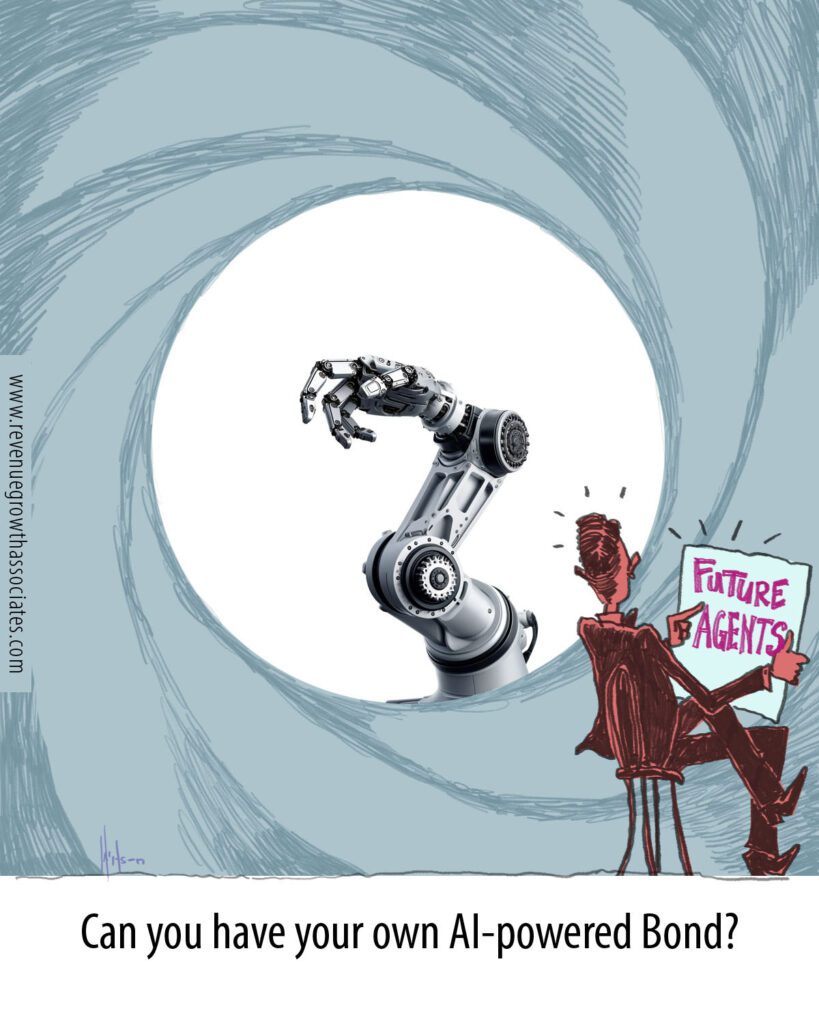Bond. James Bond. The allure of secret agents like James Bond lies in their unparalleled skills and high-tech gadgets. Now imagine having your very own AI-powered Bond on your team. The rise of ‘AI agents’ promises to revolutionize business operations bringing significant changes to how we work. But what exactly are AI agents, what tools do they have at their disposal, what are their secret capabilities, and how do they compare to the human roles they might augment – or replace? This blog dives into the design implementation and impact of AI agents, their interactions with other agents and humans, the evolving nature of work, and the new roles that might emerge.
AI Agents vs. Human Roles
While there are different types of agents with varying degrees of capability, progress is being made in developing AI agent and orchestration architectures that can perform specific tasks or entire jobs traditionally carried out by humans. Unlike humans, these agents can work tirelessly, process vast amounts of data quickly, and execute tasks with precision if designed correctly. However, they currently lack the intuition, emotional intelligence, and creativity that humans bring to the table—although this might change as we move closer to AGI. As AI agents become more sophisticated, the dynamics of workplace roles will shift, necessitating a reevaluation of human roles and responsibilities.
Designing AI Agents
Creating effective AI agents requires careful consideration of several factors. Deploying agent co-pilots to enhance human performance is often a first step for organizations and can be beneficial. However, as more agents are developed that match or exceed human capabilities and as role definitions change based on new AI-staffed business operating models, key design decisions must be considered:
• Purpose and Scope: Define tasks and goals clearly. Future-state operating models will require different, often new, roles.
• Interactivity: Ensure seamless interaction with humans and other AI agents, clearly defining and delineating roles for humans, agents, and joint tasks.
• Adaptability: Enable learning and adaptation to new information and environments, considering changes in underlying LLMs and job-specific training.
• Tools and Data: Define the tools and data that the AI agent will need to access to perform their role. While LLMs are great at reasoning and natural language processing, for an AI agent to work in most operating structures, the agent needs to connect with other systems, data stores, and enterprise toolsets.
• Ethics and Transparency: Incorporate ethical guidelines and transparency in decision-making. Given the current “black box” nature of AI, establish guardrails to ensure agents act in ways that safeguard the business.
Future Interactions
As AI agents become more prevalent, interactions between AI agents across organizational boundaries will increase. For example, a ‘sales agent’ might become the primary interface for a customer’s ‘buying agent,’ both operating with high efficiency and data-driven precision. Additionally, a consultative seller with AI-enabled ‘bionic capabilities’ might have sales support roles—such as Solution Engineer, Legal, Contracts, Finance, and Industry Expertise—filled by agents instead of humans. This shift also raises numerous questions about how other sales support functions, like sales operations and sales enablement, should evolve as the GTM model starts to include agents as a key part of the mix.
Emerging Roles
While AI agents will replace certain roles, their rise will also create new roles within enterprises—such as “Agent Manager” or “Function Control Room Operator.” (for more on this, see our previous blog on control rooms at Redefining the Corporate Operating Model. These roles, sometimes referred to as “Human in the Loop,” are responsible for overseeing AI agents’ performance, addressing complex issues beyond the agents’ capabilities, and ensuring alignment with organizational goals.
HR for Agents?
Will AI agents require HR support? Human Resource professionals in most companies today focus on developing and supporting the business’s human capital. But what if the ‘human’ is no longer a ‘human’? HR may need to evolve to support a workforce that includes both humans and AI agents. This might involve defining new roles and job descriptions for a human/AI agent operating model, assisting with AI agent design and training, and managing the integration of AI agents into the human workforce. Additionally, HR will play a critical role in reskilling humans for success in an AI-enabled operating structure. The cost and effort required for these activities should not be underestimated. As one data point, a recent McKinsey study indicates that change management costs can be up to three times higher than the technology costs when implementing AI. This underscores the importance of investing in comprehensive change management strategies to support the successful integration of AI into business operations.
Let Your Vision Define Your Agents
At Revenue Growth Associates, we emphasize the importance of developing a Strategic Visual Blueprint™. This blueprint helps organizations visualize the future state of their operations, incorporating AI agents and identifying the roles and skills necessary for success. By leveraging a Strategic Visual Blueprint™, businesses can navigate the complexities of AI integration and position themselves for future success. They can also ensure that their AI agents are effectively designed, implemented, and managed to complement human roles and drive overall business success. Ready to design your future business operations landscape consisting of both humans and AI agents? Connect with us today to schedule your free one-hour blueprint design consultation call. We’d love to show you how this might just be the differentiated approach you need to start thinking about your workforce of the future.


